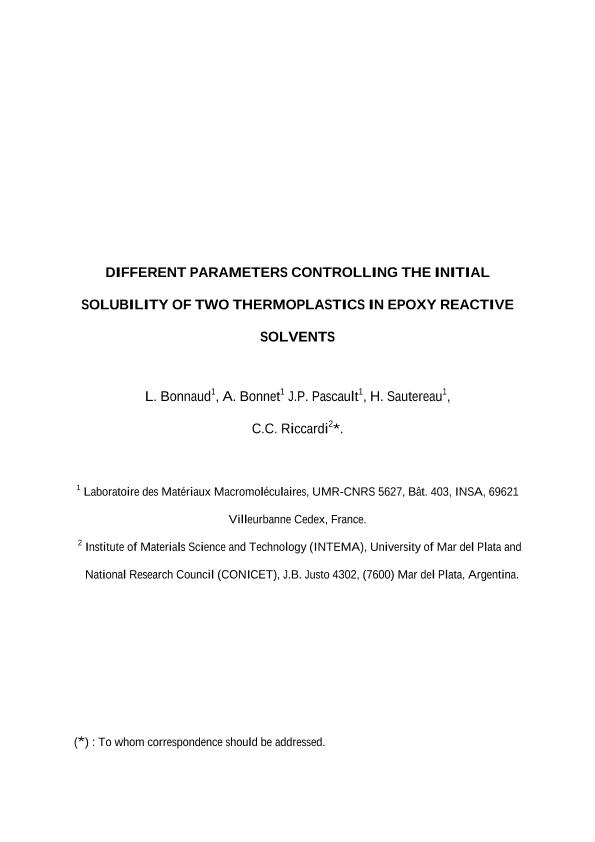Mostrar el registro sencillo del ítem
dc.contributor.author
Sautereau, H.
dc.contributor.author
Pascault, J. P.
dc.contributor.author
Bonnet, A.
dc.contributor.author
Bonnaud, L.
dc.contributor.author
Riccardi, Carmen Cristina

dc.date.available
2018-02-21T19:40:45Z
dc.date.issued
2002-02
dc.identifier.citation
Sautereau, H.; Pascault, J. P.; Bonnet, A.; Bonnaud, L.; Riccardi, Carmen Cristina; Different parameters controlling the initial solubility of two thermoplastics in epoxy reactive solvents; John Wiley & Sons Inc; Journal of Applied Polymer Science; 83; 6; 2-2002; 1385-1396
dc.identifier.issn
0021-8995
dc.identifier.uri
http://hdl.handle.net/11336/36893
dc.description.abstract
The influence of different factors on the miscibility of diglycidyl ether of bisphenol A (DGEBA)/thermoplastic blends was studied. DGEBA/poly(ether imide) (PEI) blends exhibited upper critical solution temperature behavior. The addition of a trifunctional epoxy [triglycidyl para-amino phenol (TGpAP)] increased the miscibility window. The addition of diamines as hardeners could also increase [4,4′-methylene-bis(3-chloro-2,6-diethylaniline) (MCDEA)] or decrease (4,4′-diaminodiphenylsulfone) the miscibility window. DGEBA/poly(ether sulfone) (PES) blends showed lower critical solution temperature behavior. The addition of TGpAP had an effect similar to that for PEI blends, but the presence of MCDEA as a hardener decreased the miscibility of epoxy/PES blends. The modeling of the cloud-point curves was performed with the Flory-Huggins equation (Flory, P. J. Principles of Polymer Chemistry; Cornell University Press: Ithaca, NY, 1953; p 672) according to the procedure developed by K. Kamide, S. Matsuada, and H. Shirataki (Eur Polym J 1990, 26, 379), with the interaction parameter used as the fitting parameter. A phenomenological model that takes into account the molar mass of DGEBA and the amount of TGpAP is proposed and is found to predict the cloud-point temperature of any TGpAP/DGEBA/PEI blend.
dc.format
application/pdf
dc.language.iso
eng
dc.publisher
John Wiley & Sons Inc

dc.rights
info:eu-repo/semantics/openAccess
dc.rights.uri
https://creativecommons.org/licenses/by-nc-sa/2.5/ar/
dc.subject
Flory-Huggins Equation
dc.subject
Phase Diagrams
dc.subject
Phase Separation
dc.subject
Poly(Ether Imides)
dc.subject
Poly(Ether Sulfones)
dc.subject
Thermoplastic-Modified Epoxies
dc.subject.classification
Otras Ingeniería Química

dc.subject.classification
Ingeniería Química

dc.subject.classification
INGENIERÍAS Y TECNOLOGÍAS

dc.title
Different parameters controlling the initial solubility of two thermoplastics in epoxy reactive solvents
dc.type
info:eu-repo/semantics/article
dc.type
info:ar-repo/semantics/artículo
dc.type
info:eu-repo/semantics/publishedVersion
dc.date.updated
2018-02-19T16:54:52Z
dc.journal.volume
83
dc.journal.number
6
dc.journal.pagination
1385-1396
dc.journal.pais
Estados Unidos

dc.journal.ciudad
New York
dc.description.fil
Fil: Sautereau, H.. Centre National de la Recherche Scientifique; Francia
dc.description.fil
Fil: Pascault, J. P.. Centre National de la Recherche Scientifique; Francia
dc.description.fil
Fil: Bonnet, A.. Centre National de la Recherche Scientifique; Francia
dc.description.fil
Fil: Bonnaud, L.. Centre National de la Recherche Scientifique; Francia
dc.description.fil
Fil: Riccardi, Carmen Cristina. Consejo Nacional de Investigaciones Científicas y Técnicas. Centro Científico Tecnológico Conicet - Mar del Plata. Instituto de Investigaciones en Ciencia y Tecnología de Materiales. Universidad Nacional de Mar del Plata. Facultad de Ingeniería. Instituto de Investigaciones en Ciencia y Tecnología de Materiales; Argentina
dc.journal.title
Journal of Applied Polymer Science

dc.relation.alternativeid
info:eu-repo/semantics/altIdentifier/doi/http://dx.doi.org/10.1002/app.10029
dc.relation.alternativeid
info:eu-repo/semantics/altIdentifier/url/http://onlinelibrary.wiley.com/doi/10.1002/app.10029/full
Archivos asociados
